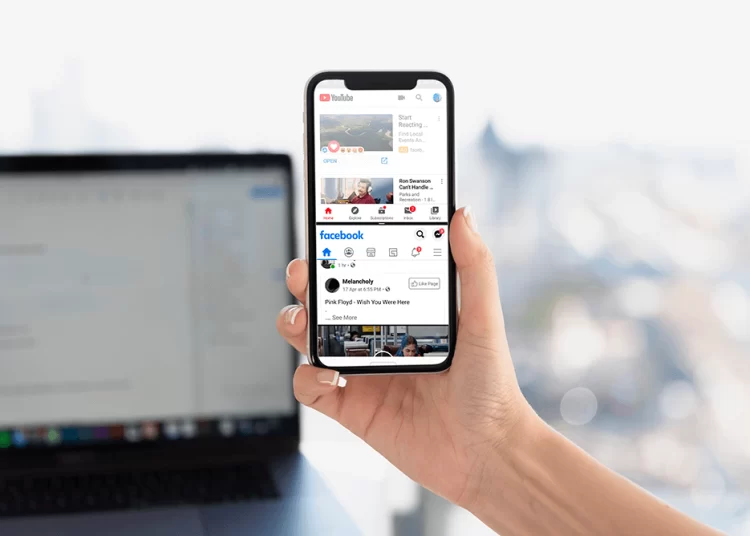If you are curious about what Android split screens are and how they can benefit you, then what an Android split screen is in detail, along with a list of the top ten benefits it offers.
This feature on Android devices greatly enhances your user experience with its multitasking capabilities, improved organization, and improved organization.
Table of Contents
Introduction:
The android split screen is a feature that allows users to divide the screen of their Android device into two separate sections, each of which can display a different app or activity.
You will be able to multitask like never before thanks to Split Screen – you will be able to check your email while watching a video or check your calendar while surfing the web at the same time
What is Android Split Screen?
Android split screen, also known as multi-window mode, is a feature that was introduced in Android 7.0 Nougat and is available on most modern Android devices. With a split screen, users can open and view two apps at the same time, allowing them to multitask and improve productivity.
Once the top app is selected, users can then select the app they want to display on the bottom half of the screen. The two apps will then be displayed side by side, with a dividing line between them.
Top 8 Benefits of Android Splits The Screen:
Android The Screen offers several advantages.
1.Enhanced multitasking:
Using a split screen, users can take notes on one side of the screen while watching a video on the other, or compare prices on different sites without switching tabs.
Better use of screen real estate:
Using split screen, users can take notes on one side of the screen while watching a video on the other, or compare prices on different sites without switching tabs.
2.Easy app switching:
Increase the efficiency of your device’s screen real estate Split screens allow you to make better use of your device’s screen space, particularly on larger devices.
3.Improved organization:
Switching between apps is easy with a split screen: switching between apps does not require exiting one app and opening another.
4.Organizational improvement:
Split screen allows users to manage multiple apps simultaneously on one screen, making it easier to complete multiple tasks at the same time.
5.Entertainment enhanced:
Split screen displays allow users to watch a video on one side of the screen while conversing with friends on the other, or to play a game while browsing social media on the other.
6.Customization:
Many Android devices allow you to customize the size and layout of the split screen, allowing you to tailor it to your specific needs and preferences.
7.Improved accessibility:
Splitting the screen can make it easier to use your device if you have vision or mobility impairments, as it allows you to see and interact with multiple apps at once.
8.Enhanced online shopping:
Shopping online has been enhanced with split-screen technology, which allows shoppers to browse different websites and compare prices and reviews at the same time, allowing them to make educated purchasing decisions.
Advanced Android split screen features:
The following are some of the advanced features.
Multi-window mode
Android also has a multi-window mode, which allows users to display more than two apps simultaneously in addition to split-screen mode. Long pressing the Recent Apps button and tapping the Split Screen option will activate the multi-window mode.
This will display a list of recent apps, and users can select up to three apps to display at the same time.
The apps will be displayed side by side, with a dividing line in between each one. Users can adjust the size of each app window by dragging the dividing lines left or right.
How to move and close windows ?
To move an app window in split screen or multi-window mode, users can simply drag the app window to the desired position.
To close an app window, users can either swipe the app window off the screen or tap the “X” icon in the top right corner of the app window.
Split-screen swipe gestures
Android also includes a number of swipe gestures that can be used to navigate and manage split screen and multi-window mode.
To switch between app windows, users can swipe left or right on the dividing line. This allows them to quickly switch between apps without having to exit split screen mode.
To close an app window, users can swipe down on the dividing line. This will close the app window and exit split screen mode.
To maximize an app window, users can swipe up on the dividing line. This will expand the app window to fill the entire screen, allowing users to focus on a single app.
How to Use Android Split Screen?
To use a split screen on an Android device, follow these points:
- Open the first app that you want to display on the top half of the screen.
- Long press the recent apps button to display a list of recent apps.
- Tap and hold on to the app icon of the second app that you want to display on the bottom half of the screen.
- Drag the app icon to the top of the screen to place it on the top half of the screen.
- The first app will automatically be moved to the bottom half of the screen.
- You can adjust the size of each app window by dragging the dividing line left or right or switch the position of the two apps by dragging the dividing line to the top or bottom of the screen.
FAQs:
1.Can I resize the apps in Android Split Screen?
Yes, You are able to resize the apps in Android Split Screen by dragging the borderline between the two applications. Drag the border line up or down to change the size of the apps.
2.Can I use split screen mode on my Android phone?
There are many Android phones that support split-screen mode, including devices running Android 7.0 (Nougat) or higher.
Conclusion:
Android also provides a multi-window mode that enables users to display up to three apps simultaneously, as well as swipe gestures that facilitate managing and navigating multiple app windows simultaneously.
Despite the fact that not all apps are compatible with split screens, most modern apps support this feature and can prove to be an invaluable tool for those seeking to maximize their Android device’s potential.
Android’s operating system provides users with the option of dividing the screen into two separate sections for the display of different applications and activities. Tablet computers, for example, offer a larger screen that can enhance multitasking and productivity. Users can open and view two applications simultaneously using split screen, enabling them to switch more easily between them and accomplish tasks more efficiently.










![Is Tokyo Ghoul on Netflix? [How to Watch Online]](https://avctv.com/wp-content/uploads/2022/08/AAAABct1DaUzhEt4JeJFeDrmaE_4CGAu39fBN6poMx10hAlWlMRjkkAw84hjmuujWTy2wFC7_Pjnujec-_PqT1GCnnMFMJ15S04baJn1b0WvvbG6hrSNb31_GS4--120x86.jpg)





